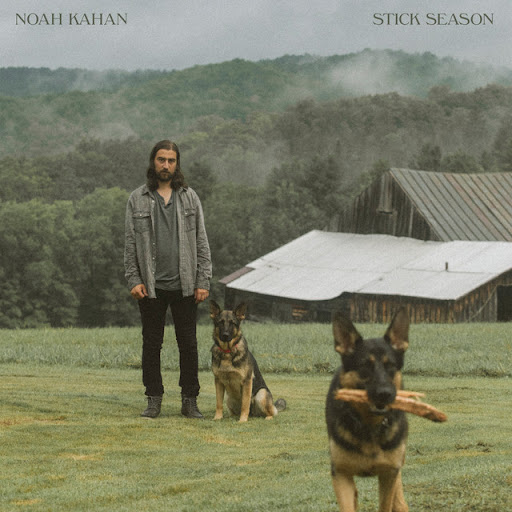At its core, Noah Kahan’s latest album is an ode to not knowing. Each track is a tangled snarl of questions about purpose, growth, loss and what it means to be left behind, to which Kahan offers the listener only incomplete and often self-contradictory answers. However, amid all the darkness and uncertainty, Kahan’s rough, playful vocals, creative lyricism and musical complexity make the listening experience a bright one.
“Stick Season” is Kahan’s third full-length studio album, following “I Was/I Am,” which came out in September 2021. Unsurprisingly, Kahan’s newest work shares many themes with his earlier albums and EPs, including mental health, family trauma and the experience of growing up in small-town Vermont. However, while “I Was/I Am” and its predecessor, “Busyhead,” are mostly forward-looking albums, “Stick Season” is very much an examination of things left behind, including relationships (“Stick Season,” “All My Love”), childhood (“Come Over”), Kahan’s hometown (“Halloween”) and Kahan himself (“New Perspective”).
Thematically and literally, “Stick Season” is a fall album; not only was it released in mid-October, but all its tracks revolve around transition and loss, both of which are traditionally associated with the autumn months. Kahan confirmed this in an interview with Insider, where he described “stick season” as “the time between peak foliage and Halloween and the first snow — when all the leaves are off the trees. It’s a time of transition. And it’s super depressing.” And, indeed, Kahan’s latest album is not a cheerful one. Even for Kahan, whose music has always dealt with subjects many artists hesitate to touch, like alcoholism and depression, “Stick Season” feels surprisingly heavy. It is often angry; in multiple tracks, there is genuine bitterness in Kahan’s voice.

Courtesy of Republic Records.
However, “Stick Season” is more emotionally complex than it appears at first glance. In between moments of angst, there are a number of heartfelt tributes to the people and places Kahan still loves. The most obvious example is “All My Love,” a catchy track about a failed relationship, in which Kahan tells his ex-lover, “I’m the same as I was, it’s all okay/ Therе ain’t a drop of bad blood, it’s all my love.” And in “Strawberry Wine,” a gentle, soothing song reminiscent of something Hozier would write, Kahan points to the beauty of first love, despite its inevitable end: “I said love is fast asleep/ On a dirt road with your head on my shoulder.” Kahan is bitter and angry, but he is grateful, too.
Despite being primarily an indie folk album, “Stick Season” is impressively diverse in its production. “Northern Attitude,” the opening track, harkens back to early Mumford & Sons with its stacked harmonies, prominent banjo and a big, echoing chorus that could fill stadiums.
In contrast, the electric guitar, rough vocals and loud, technically complex drums in “Homesick” draw a comparison with modern indie rock, especially in the last 30 seconds. And, although the foot-stomping, guitar-strumming choruses of songs like “Northern Attitude” and “Orange Juice” are extraordinarily memorable, the album also benefits from sparser tracks like “Halloween,” which builds an eerie landscape of sound from nothing more than plucking guitar, a deep background hum and the anxious flutter of a violin.
Kahan knows when to flip between fast and slow, loud and soft and intricate and simple. Tracks like “Homesick” also demonstrate his talent for highlighting specific moments in each track, which he does throughout the album, dropping the production for a second to make a lyric sparkle or using drums and his vocal talent to propel an already lively chorus to its roaring, breathless, joyful peak. Notably, this is the first of his albums that Kahan has co-produced.
More so than previous albums, “Stick Season” clearly demonstrates his capacity to be vocally adventurous, as he experiments with flow, vocal riffs, and even the tenor of his voice (in the chorus of “New Perspective,” he leans into a bit of country twang; the last 60 seconds of “Homesick” are practically a yell). In addition, Kahan has always been a thoughtful, creative lyricist, but “Stick Season” contains some particularly exemplary wordplay, with gems like, “But love leaves little runway and every time I run straight over it” and “Kept on driving straight but left our future to the right.” And, references to symbols of death throughout the lyrics — including bones, coffins, graveyards and crows — subtly underline the themes of change and loss. This is an album of ghosts, after all. In “Halloween,” Kahan says it outright: “I’m leaving this town and I’m changing my address/ I know that you’ll come if you want/ It’s not Halloween but the ghost you dressed up as sure knows how to haunt.”
With all this creativity and experimentation, it is somewhat remarkable that “Stick Season” feels like Kahan’s most cohesive album yet. Part of this stems from the clear-cut nature of the album’s themes — loss and transition — but there is also something to be said about how Kahan structures the album, particularly the opening and final tracks. In “Northern Attitude,” he asks what could be seen as the album’s core questions: “Where are you? What does that mean?” In other words, is Kahan home? Is he leaving home? And what is the emotional impact of leaving versus staying? Although the vast majority of the album leaves the answers to these questions unclear, by “Homesick” and “Still,” the 13th and penultimate track, respectively, it appears to be approaching something like acceptance.
And then, of course, comes the final track, “The View Between Villages,” a masterclass in structure and symbolism. The song begins with a very quiet, sparse production, leaving Kahan’s echoing vocals to float on top of mostly empty space. The lyrics also reinforce the feeling that Kahan is ending softly: “I am not scared of death/ I’ve got dreams again/ It’s just me and the curve of the valley/ And there is meaning on Earth, I am happy.” “I am not scared of death” is particularly significant, given that death is one of the album’s themes — it suggests that Kahan is finally at peace with loss.
But, just as “Stick Season” has refused to give uncomplicated answers, “The View Between Villages” turns this moment of peace and clarity on its head with the next verse. As the production ramps up dramatically, adding the kick drums, banjo and shouted vocals that define Kahan’s catchiest folk anthems, Kahan tells us, “The death of my dog, the stretch of my skin/ It’s all washing over me, I’m angry again.” The very end of the track returns to the quiet, sparse production of the beginning, an about-face reflected in the lyrics: “The car’s in reverse, I’m grippin’ the wheel/ I’m back between villages and everything’s still.” To punctuate that stillness, the last 30 seconds of the track end in practical silence, except for a soft, echoing synth that gradually fades out.
Ending an album of contrast and contradictions with more contrast and more contradictions is an unusual move; many artists would probably choose to conclude with catharsis, not uncertainty. But this particular ending demonstrates Kahan’s confidence in the album’s emotional and musical vision: “Stick Season” is an album of conflict and contrast and reversal, and yet, despite that, it knows exactly what it is and what it wants to say.
Mila Kocic (26C, she/her) is from the Boston area, major TBD. She spends her free time reading poetry, exploring Atlanta's arts scene, and making unnecessarily specific Spotify playlists.





